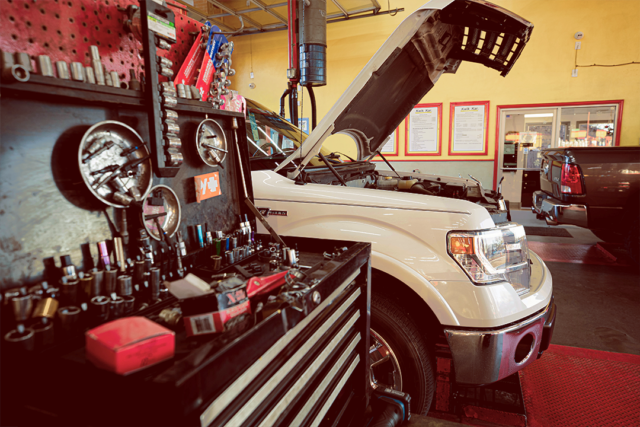Most of us don’t think about our cars’ impact on the environment beyond gas prices or how often we have to fill up. But every vehicle on the road contributes to emissions, and the way you maintain yours plays a much bigger role in your carbon footprint than you might expect. In this post, we’re looking at how small maintenance habits can add up to a lower carbon footprint. We’ll cover how neglected car care leads to higher emissions, the data behind it, and what drivers can do to make a real difference to lower carbon emissions.
The Worst Ways Vehicle Neglect Harms the Environment
Your carbon footprint goes a lot deeper than emissions from slamming on the gas and spewing out exhaust fumes. Poor maintenance leads to unseen damage that adds up over time, making your vehicle a bigger polluter than you might realize.
Issue |
How It Harms the Environment |
| Leaking Fluids | Oil, coolant, and transmission fluid can drip onto roads and wash into waterways, contaminating ecosystems and harming wildlife. |
| Worn-Out Engine Components | A poorly maintained engine burns fuel inefficiently, releasing higher levels of CO₂, carbon monoxide, and nitrogen oxides into the air. |
| Overdue Oil Changes | Dirty oil increases friction, making your engine work harder, burn more fuel, and pump out excess emissions. |
| Ignoring Check Engine Warnings | Problems like a faulty oxygen sensor can reduce fuel efficiency by up to 40%, leading to unnecessary pollution. |
Just How Bad Is It?
- A single car leaking oil can contaminate a million gallons of water. That’s the equivalent of an Olympic-sized swimming pool filled with pollution.
- Studies show that faulty oxygen sensors are responsible for 40% of reduced fuel efficiency per year in the U.S. alone.
- Low tire pressure increases CO₂ emissions by about 1.5 million tons annually because of extra fuel consumption.
How You Can Make a Big Difference
Reducing your car’s environmental impact doesn’t mean you have to give up driving. There are practical ways to minimize pollution without a major lifestyle change. Here’s where you can start:
- Choose Fuel-Efficient Driving Habits – The way you drive matters. Gradual acceleration, coasting to a stop instead of hard braking, and avoiding excessive idling can improve fuel efficiency and reduce emissions.
- Lighten Your Load – Carrying extra weight forces your engine to work harder, burning more fuel energy. Remove unnecessary items from your trunk and roof racks when they’re not in use.
- Be Smart About Gas – Opt for quality fuel from reputable stations. Lower-grade or contaminated fuel can cause buildup in your vehicle’s engine and cause more emissions over time.
- Use Eco-Friendly Car Washes – Traditional driveway washes send harmful chemicals and oil runoff into storm drains. Professional car washes are designed to filter and recycle water, preventing pollution.
- Properly Dispose of Old Car Parts and Fluids – If you change your own oil or replace parts, don’t toss them in the trash. Many auto shops and recycling centers accept used oil, batteries, and other hazardous materials to prevent contamination.
How Regular Maintenance Lowers Environmental Impact
Keeping up with your vehicle’s maintenance is one of the most effective ways to reduce unnecessary emissions and environmental damage. Taking your car to a professional mechanic will help guarantee that repairs are handled properly and that hazardous waste is disposed of the right way.
Shops like Kwik Kar follow strict environmental regulations to safely dispose of old oil, coolant, and other fluids instead of allowing them to leak into the environment. Mechanics also conduct emissions system checks, catching issues like malfunctioning oxygen sensors that can cause excessive fuel waste.
Beyond emissions control, professional mechanics help make sure your tires are properly inflated and aligned. This prevents unnecessary fuel consumption due to increased rolling resistance. Staying on top of routine inspections helps catch things like small leaks, worn engine components, or other hidden issues before they turn into bigger (and even more polluting) problems. Although DIY maintenance is great for some tasks, professional service guarantees that waste is handled properly and that your car isn’t putting out more emissions than necessary.
A Simple Way to Reduce Your Carbon Footprint
You don’t need to drive an electric vehicle or avoid driving altogether to be more environmentally responsible. A well-maintained car runs more efficiently, wastes less fuel, and produces fewer emissions.
Just How Much of a Difference Does It Make?
Here’s how specific actions can make a measurable difference:
- Fixing a Faulty Oxygen Sensor: A malfunctioning oxygen sensor can decrease fuel efficiency by up to 15%. Replacing it can save approximately 1.5 billion gallons of fuel annually in the U.S., reducing carbon emissions substantially.
- Maintaining Proper Tire Pressure: Keeping your tires properly inflated can improve fuel efficiency by up to 3%.
- Regular Oil Changes: Clean oil reduces engine friction, allowing it to operate more efficiently. This maintenance can lead to better fuel economy and lower emissions, although specific savings vary based on vehicle and driving conditions.
- Proper Fluid Disposal: Improper disposal of motor oil can lead to significant environmental contamination. For instance, a single quart of motor oil can pollute up to a million gallons of water.
Not everyone is focused on being eco-conscious all the time, and that’s okay. However, when it comes to vehicle maintenance, there are plenty of small ways to make a meaningful impact on the environment. Simply just following a consistent maintenance schedule and upkeep for your vehicle can reduce unnecessary emissions and prevent avoidable pollution by a significant amount.
You can always start at Kwik Kar with a full vehicle inspection to get a clear timeline on what your maintenance should look like. And, of course, encouraging others to do the same only adds to increasing a positive environmental effect.










